Summer Study '98: What Did the Phase I Scholars Do?
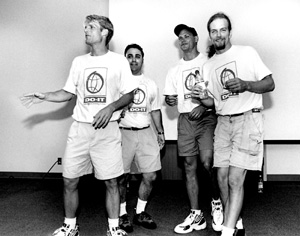
DO-IT Phase I Scholars participate in a two-week, live-in summer study session on the University of Washington campus in Seattle, Washington. They learn about college life; surf the Internet; interact with peers, staff, and mentors; and have fun. Below, '98 Phase I Scholars share some of their experiences. A few more of their articles will appear in the next issue of DO-IT News. Note that, reluctantly, some articles were edited by DO-IT staff to make them short enough to include in this publication. Additional articles by Scholars can be found in earlier newsletters at www.washington.edu/doit/news/do-it-news.
DO-IT with Slime
by DO-IT Scholars, Abe and Todd
The lab that we did, called the slime lab, was a very interesting experience. We went to a chemistry lab and mixed sodium bromide with glue and water. The result was this gooey slime material that was slippery and wet. After the first slime was finished all of the different groups changed a small part of the lab to make different variations to the slime. In one variation the slime was transparent.
Searching the 'Net
by DO-IT Scholars, John and Chris
When conducting a search on the Internet the number of options on the 'Net can be overwhelming. Luckily, there are many places on the 'Net where you can base your search. These sites, called search engines, are databases of different Web sites that are categorized. Search engines are not all the same. Some are better than others.
The search engine Yahoo! is one of the most widely used search tools on the Web. Yahoo! is also much more than a search tool. It has a classifieds section and it has a yellow pages section. We've found that this engine is particularly useful for looking up things that are related to personal interests. Unfortunately, if you use a category search you will probably be bounced around with the many cross links that are throughout the site.
Lycos is a good search engine when you want to search for pictures or sounds or other multimedia and not go through several pages of text to get what you want. The format for the search is pretty easy and the site isn't bogged down by excessive links. The major downside to Lycos is that if you intend to do a search by categories they are presented in a way that the categories sound entertaining and appealing- not too good for a serious search.
The search engine Alta Vista gives you a lot of sites when you search. This is okay if you are planning on spending a lot of time doing your search or if you are good at narrowing down what you plan to search for but if you want to do a quick search you can be easily bogged down at this site.
The most important thing to do when you are using search engines is to familiarize yourself with as many as possible and to learn how to effectively narrow down your search. Don't use a single engine exclusively.
DO-IT Introduces Advanced Web Use
by DO-IT Phase II Scholars, Corey and Reginald
During the '98 Phase I Scholar Summer Study, Dan Comden commissioned a group of experienced Internet users to help redesign the DO-IT home page. The group worked in HTML, performing various tasks, including the addition of education links, and repositioning of the graphic to make the page more aesthetically pleasing, while still maintaining the accessibility features for individuals with various impairments.
Dorm Life-We DID-IT!
by DO-IT Scholars, Eddie and Silas
Last summer at DO-IT was the first time we had ever been in a dorm. We thought it was fun. We were roommates. We kept each other company. The best thing about living in a dorm is that you're on your own and you can do lots of things like stay up late on the phone. No one cares except the person you are talking to, as long as you get up in the morning. It was a good experience because now we know what it's like to go to college and manage on our own. Life doesn't give you all that you need so you have to reach out and grab for things. At first we didn't really understand that but now we do. Dorms aren't perfect so you will have to ask for staff if you need it, but that part of being on your own overall is not as bad as it sounds. We learned a lot of new things-like that the rooms are small and they get cold fast if you leave your fan on all night. The people at the front desk are nice and friendly. If you have a question they always answer it. Dorms are neat and clean. The bathrooms are clean when you go in but they are messy when you leave. The showers are like a high school locker room, with the shower head hitting you in the chin.
Doing Up Our Dorm Room at DO-IT
by DO-IT Scholars, Crystal and Jessie
During the DO-IT program the Scholars stayed in the McCarty Hall dormitory on the University of Washington campus. The boys got one floor and the girls got another. We got room 268 on the second floor. Our room was one of the six rooms on the girls' floor. All of the dorm rooms in McCarty Hall are virtually identical. The dorm room is like a 13' by 17' shoe box. The rooms are made for two people to share so every piece of furniture has a twin next to it. The two cream colored, stair formation beds lay against the wall and opposite of the mirror. The mirror is mounted on the wall on top of a counter. Underneath the counter are two dressers with five drawers each. On both sides of the mirror there are closets to hang clothes in and store luggage in or anything else you need to. There are also two work areas with three-drawers desks. Each has a light above it and a window beside it. The dorm also provided us with a phone with voice messaging and a direct line.
The dorm rooms were very efficient but boring. We, being the creative people we are, couldn't stand the plain white walls. We had to do something. The second night we had this crazy idea to decorate our walls with magazine advertisements. We stayed up late that night tearing out pictures and taping them to our walls. We went crazy. In the end we had a huge collage of colorful pictures covering a big space on two walls. After that we were still not satisfied. Our room was still missing something. Then we had a great idea. One of us had flamingo and palm tree Christmas lights that we strung above our mirror. It was just what we needed to make our room perfect!
The Microsoft Experience
by DO-IT Scholars, David and Wesley
On Friday, August 7, DO-IT Phase I Scholars toured Microsoft. We had an incredible time. Our tour started off with an overview of Microsoft's general information and vision. Here are some of the most astounding statistics we learned: Microsoft is the leading manufacturer of software in the world. There are 25,000 employees that work for Microsoft worldwide. According to Bill Gates, Microsoft's vision is to "have a computer on every desk, in every home, in every school." Microsoft has a serious commitment to disabled employees, according to its benefits manager. They provide such things as special hardware, sign language interpreters, office restructuring and personal assistants. Microsoft reviews its accommodations requests on a case by case basis and has a dedicated staff to deal with requests. However, sometimes an alternative solution that ends up with the same result is offered instead.
Microsoft employees showed DO-IT Scholars accessibility options in Windows 98 and Internet Explorer 4 (IE 4). Microsoft offers accessibility programs free to competitors to help them make their programs accessible as well. Scholars visited the Microsoft Museum. It contains both the history of the computer and of Microsoft. We loved the opportunity to play around with popular Microsoft programs such as Encarta '98 and Microsoft Flight Simulator '98. We enjoyed our time at Microsoft. It was a time to learn and experience what the computer industry has to offer.
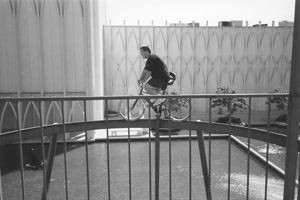
Pacific Science Center
by DO-IT Scholars, Jessie and Maggie
On Saturday August 8, the DO-IT Phase I Scholars participated in an off-campus activity at the Pacific Science Center located in Seattle. During the day, the Scholars participated in various activities. Some activities were done as a group, like the IMAX and laser shows. Others were done in smaller groups, such as visiting the Space Needle, and other attractions.
Shortly after arriving the Scholars attended an IMAX movie presentation entitled "Alaska." The movie focused on the affects of nature and wildlife due to change of the season. The large screen provided a realistic feeling for the audience. After the IMAX presentation the Scholars attended a laser show. The theme of the show focused on space. Many Scholars had different opinions about the show. Some felt that it was very entertaining and exciting while others were dizzy and nauseated.
Next, many of the Scholars decided to tour the Space Needle. "The view from the observation deck was spectacular," says Maggie, a Phase I Scholar. While the Space Needle is a very popular attraction, it may be challenging for people with mobility impairments to enjoy the entire view. Unfortunately, the observation deck outside is not accessible to wheelchairs.
The Phase I Scholars had a fun-filled day at the Pacific Science Center and other attractions near the Science Center.
Finding Your Rainbow
by DO-IT Scholars, Jeff and Landon
On Wednesday, August 5, Grahman Allen talked to the Phase I Scholars on "Finding Your Rainbow" which means finding your own road to success. He challenged us to be creative. We all are individuals and our thoughts are the sum of our own experiences and no one else has the same experiences. Often the greatest inventions come from the simplest thoughts and needs. When developing a concept, you should be able to answer any questions that arise. Think like a journalist, asking yourself "who, what, where, when, why and how." If you can answer all of these questions, you may have come up with a creative, innovative concept. People are impulsive and only think for a few minutes each day. Don't let what you can't do get in the way of what you can do. Being creative and innovative is something we all can do and for which companies will pay top dollar.
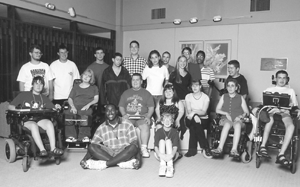
Museum of Flight
by DO-IT Scholars, Ivan and Dustin
As we drove down Interstate 5 from downtown Seattle to south of the city we peered into the sky and saw as many as six of the best top gun pilots in the air above. These flying aces maneuvered above our heads as if they were majestic eagles. The Blue Angels are a sign of America's air strength. Boeing International airfield is a temporary home to these F-18s during Seattle's SeaFair Celebration. Boeing is the top airplane manufacturing company in the world. It also houses a museum on its property along with most of the manufacturing plants, a runway and hangars.
We pulled up to the museum, a large red barn connected to a more contemporary building, and climbed out of the charter buses into a large plaza. The staff had a box lunch prepared for each of us, a fulfilling meal in hand. We entered the buildings large glass doors using our bright yellow pins to get passed the guards. We met up with an older gentleman who led us on a one-hour tour of the facilities, during which time he provided us with interesting information regarding the history and technical variations on the assorted planes which were on display throughout the museum.
A true variation of planes and helicopters were strewn across two levels and hanging jets. The sky level featured glider and other lightweight flying contraptions as well as a helicopter. The ground level had neatly placed fighter jets and older flyers. The ground level also featured a flight simulator. For three dollars you could sit in a box with nine others and be tossed around like a bag of potatoes. This was a sorry excuse for an amusement ride, well for three bucks that is. The bottom level held the crowned jewel of the museum, a blackbird spy plane. An interesting thing was the car plane that could be a plane or a car in just a matter of minutes. Unfortunately it never hit the market.
For a comprehensive history of air travel and pioneer aviators, we entered a large red barn which had been previously owned by the Boeing company. This contained bio sketches of early men and women of flight, as well as some prototype engines and other mechanisms related to planes.
In remembrance of our venture at the museum of flight we browsed the full and complete gift shop, purchasing mementos for our friends and families. All in all, this visit was one of the highlights of our trip to Seattle.
The Heart of It
by DO-IT Scholars, Justin and John
We started the day by doing the usual routine, eating breakfast, going to the HUB computer lab, checking our e-mail, and returning mail to others. The day is August 11. At about 11:00 am we headed for the Mechanical Engineering Building, just down from the HUB. There we met our science instructor, Laurie Clark.
She started out by telling us her past-who she is, what she does. Then she said, "Today we are going to perform three tasks on a heart that came from a sheep: first is a bypass, second is a valve replacement, and third is to explain what blue baby syndrome is." We were not in the same group, but we both had the experience of doing it. It was fun, wet, slimy, gooey, and we liked it very much. We first did the bypass from one of the arteries to the biggest artery on the heart. We took a tube and bypassed it to the biggest artery on the heart, cut a hole in the side of it and stuck the tube through it, bypassing the tube from one of the arteries to the other. When we were done it looked like a purse for doctors.
Second, we had to replace a valve in the heart. First we had to make a 1- to 2-inch cut at the bottom of the heart where it is the softest. Then we had to stick our finger up the hole till it popped out the other end of the artery. Then we had to stick a piece of chalk up the artery representing the valve until it was at the top of the other end of the artery.
Third, she talked about blue baby syndrome. She talked about how we didn't use our lungs while inside our mother's womb. All the work was done by mom. She would pump blood into our body through a cord attached to our belly button and other things would be deposited there like food, water, and milk. Laurie showed us what our lungs looked like. She had a display of a lung in a tray. It was really big and it was gray because there was no blood running through the lungs.
We think that this was one of the most exciting things we did while at camp. It was a wild experience.
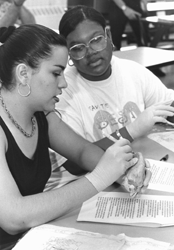
DNA Lab
by DO-IT Scholars, Emily and Jessica
DNA is a complex protein commonly called the "building block of life." In this activity we got an up-close look at the use and manipulation of DNA in the lab. The experiment we performed, called Agarose Gel Electophorese, is used in the comparison of DNA. We achieved this by injecting dyed plasmid (or engineered) DNA into a gel pack and then applying an electric current to force the DNA to spread. Before the DNA can be compared, the gel pack must be destained (or washed) in order to remove the excess dye. This activity was cool because not only did we get to perform the experiment, we could also pick up and feel everything.
Accessibility
by DO-IT Scholars, Amy, Shavonne, and Kimberlee
What exactly does the term "accessible" mean? What does it mean in public places? What does it mean for those with disabilities? In many situations, when something isn't accessible it is very difficult for people with physical impairments to function. There are lots of ways to make things accessible. For example, a wheelchair ramp can be built, Braille signs can be posted in areas around elevators for people who are blind, and visual signs displaying words can be above the restrooms in public places. The Americans with Disabilities Act and laws in many different states across the U.S. guarantee people with disabilities equal opportunities and the same rights as others. In conclusion, we would like to say that we hope public businesses are aware of the services needed for people with disabilities and make sure to provide them. And disabled people must be advocates for themselves.
Wheelchair Access: Rolling Around on Campus
by DO-IT Scholars, Nichole and Katrina
Have you ever traveled to a college and realized you can't get into a building because it's not wheelchair accessible? At the University of Washington, they try to make walkways and doorways wheelchair accessible. Although elevators are sometimes small, you can still get from floor to floor. At the UW there is always access to sidewalks, trails, doorways, and classrooms. Anyone who uses a wheelchair and wants to go to college should visit the campus in advance to check out whether it is accessible. Take the time to visit classrooms and find out how long it takes to go from one room to another.
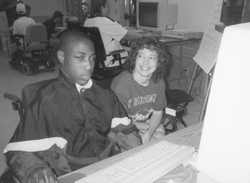
The DSS and You
by DO-IT Scholars, Justin and Michael
This year at DO-IT we not only had one presentation on the Disabled Student Services (DSS), but two. First we learned what DSS is. The second presentation was on how to approach DSS staff. The most important thing we learned is knowing who you are. Knowing who you are means knowing your strengths and weaknesses, your usual schedule and what you want to do with your life. College and university life is very different than high school and for the disabled it can be very difficult.
The disabled student services staff can be your best friend when it comes to accommodations. For example, Michael has learning disabilities. No one would know that he needs accommodations like computer use, extra time, special seating, and other accommodations. Justin, who has a physical disability, also needs extra time, special seating, computer use and much more. You need to approach the DSS office to request the accommodations you need. They can help you in many ways, like finding notetakers and getting other campus accommodations. They even can help you find a suitable dorm if you require one. In today's changing world you need to know your needs and present full documentation of your disabilities and accommodations. Contact the DSS prior to registration. It's your future. Make it a good one.